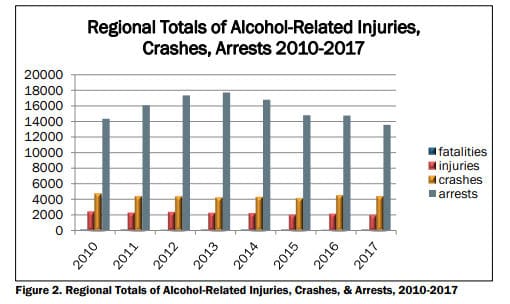
WASHINGTON — Fatalities from drunken driving in the D.C. area rose by nearly 46 percent in 2017, with the number of deaths in Maryland’s Prince George’s and Montgomery counties doubling.
Eighty-six people died in the greater D.C. area in 2017, compared with 59 in 2016, according to a Metropolitan Council of Governments report. Those are the latest statistics available.
According to the “How Safe Are Our Roads” report, prepared for the Washington Regional Alcohol Program:
Regional alcohol and/or drug-impaired traffic fatalities have increased 45.76% of total crash fatalities in the region in 2017 from 2016, compared with a decrease of 24.08% in 2016 from 2015. Nationally, alcohol-impaired fatality rates rose slightly in 2017 to 29% (compared to 28% in 2016).
Of the metropolitan Washington area’s 271 total traffic fatalities for 2017, 86 or 31.73% of these roadway deaths were due to drivers who were alcohol and/or drug-impaired.
“Fatalities didn’t just go up, but they went up significantly,” said WRAP President Kurt Erickson. “The lead came from Montgomery County and Prince George’s County in Maryland.”
Both Prince George’s and Montgomery counties saw the number of alcohol-impaired traffic fatalities double. In Prince George’s County, 34 people died in 2017, compared with 17 in 2016. In Montgomery County, eight died in 2017 and four in 2016.

Overall, the report finds area traffic crashes attributed to alcohol and/or drugs decreased 2.57 percent, from 4,438 to 4,324. And, injuries from those crashes decreased 7.14 percent from 2,074 to 1,926.
The number of arrests for driving under the influence or driving while impaired declined by 8.08 percent, from 14,757 to 13,564, the report finds.

Erickson said deaths from drunk driving are preventable.
“It’s one of the rare public health issues that’s 100 percent preventable.”
While the reason why alcohol-related traffic deaths increased remains “unknown,” Erickson said he thinks one reason traffic fatalities increased while arrests related to impaired driving decreased has to do with police. He said there are not enough law enforcement officers on the road to spot and pull over drivers before they cause accidents.
“If you ask law enforcement, most of them will tell you a large part is a staffing issue. They’re not staffed as much as they’d like to be.”
The report is intended to help local police decide where to allocate their resources.
“The ultimate goal [is] making our roadways safer for all travelers,” said Arlington County Police Chief M. Jay Farr, who chairs COG’s Police Chiefs Committee. Of Arlington’s five traffic deaths in 2017, two involved alcohol. The previous year, Arlington had no alcohol-impaired deaths and only one traffic fatality.
While some programs like SoberRide, which is run by WRAP, have helped to reduce alcohol-related accidents and deaths, that program is only active five times per year.
The rest of the year, it’s up to fellow drivers and passengers to prevent drunken drivers from hurting someone while on the road.
“There are things we can do, like reporting a drunken driver,” Erickson said. “You can report them by dialing 911 in D.C. or Maryland, and by dialing #77 in Virginia. Also, wear a seat belt. The routine wearing of seat belts is the best way to prevent injuries from crashes.”
Erickson said he believes ignition interlock devices, which prevent a previously arrested drunken driver from driving while intoxicated, can help and have helped.
“I’m hoping what we’re seeing from 2017 is somewhat of an anomaly,” he said. “But D.C.’s fight against drunken driving is far from won.”










